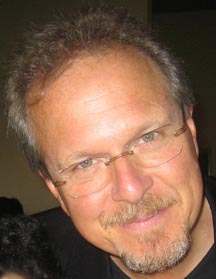
•home
MICHAEL BODDICKER
Michael Boddicker is well known as a synthesizer player, in particular for his session work with Michael Jackson on the “Thriller,” “Bad” and “Dangerous” albums. He has also worked with Barry Manilow, Celine Dion and Chicago, and has composed or played on numerous film scores, including “The Adventures of Buckaroo Banzai,” “The Adventures of Milo & Otis” and “Bulletproof.”
Boddicker is also a studio owner, having established Sol Seven Recording, an SSL-equipped facility in Sherman Oaks, California, as a private music composition room. But with the likes of Sting, Lionel Ritchie and System of a Down beating down the door to record there, he says, “I couldn’t get into my own studio!” He’s now in the process of building the eighth iteration of a private facility, taking the opportunity to also upgrade his computer system.
Over the years, Boddicker has made the transition from bulky keyboards to more streamlined PC-based setups. “I’ve had PCs for close to seven years,” he shares. “That’s when Tascam’s GigaStudio came out. I went out and bought a PC to accommodate the GigaStudio then I bought three PCs then six PCs. I fell in love with the ease.”
He elaborates, “For one thing, in previous incarnations, my setup has included as many as 128 virtual or real synthesizers. My typical studio rack would have 60 actual synthesizers, plus two keyboard stands. On the ‘Freejack’ movie and ‘Milo & Otis’ we had as many as 128 synthesizers running at once. I all but eliminated that by running three GigaStudios.”
But the PC setup was far from perfect, causing Boddicker to become disenchanted with the paradigm, until recently, when PC AudioLabs restored his faith with a system that incorporates Intel’s multi-core processor. “I had pretty much put all my PC systems aside,” he relates, noting that the technological limitations actually placed limits on his creativity. “I went through a period of over a year where I didn’t use any computerized synthesizers at all. I had put my PCs in a box, essentially. If I couldn’t play it with a mouse, and couldn’t play it on a keyboard or a guitar or a percussion instrument, or have someone else play it, then I was not interested. I essentially grew so frustrated with it that I had given up that direction.”
But the new Intel system, he says, “Beyond being a tool, has become an inspiration.”
Boddicker explains, “When I was in Pro Tools and I had a sequencer playing, if I wanted to make changes or add plug-ins the sequencer had to stop. That interrupted my workflow and mental process.” But the power of the new Intel setup has opened new possibilities, he reports. “I got over that hurdle with this new setup. That was really exciting to me. That was my religious experience with my new PC.”The break from the old system gave him some perspective, admits Boddicker. “I found out there is a world that exists beyond my way of doing things. I really benefited from a period away from it.” But with the limitations of the old PC setup removed, he says, it has expanded his creative palette. “I’m interested in writing things that sound like orchestral scores on this again. I got back to that when I had my PC AudioLabs computer hooked up running Pro Tools, using just my GigaStudio and Emulator X generating noises and was able to leave the sound playing on my GigaStudio and make mixer changes. I actually, physically felt connected for the first time with the computer as my musical instrument.”
The new rig can’t be compared to the old setup, he says. “I’ve not had one crash in my PC AudioLabs system, which I can’t say about my old systems. I’ve tried to build PC systems several different ways but I’ve never before had one that worked so effortlessly and flawlessly.”
Boddicker is no neophyte, but when he’s needed PC AudioLabs’ support it has always been there, he reports. “Because of my own lack of knowledge and lack of willingness to sit down and read a five- or six-inch pile of manuals, when I called Tom Bolton up I was made to feel like I was the main priority. I am a little dumbfounded at how they are able to maintain the level of support that they do, because it’s been flawless. I got the feeling that, for the normal times I would be operating my system, I could call and get instant service. It’s like having a partner or an engineer or an orchestrator on the project, where you have instant access.”
Photo File: Michael_Boddicker.JPG
Intel is a registered trademark of Intel Corporation or its subsidiaries in the United States and other countries.
* Other names and brands may be claimed as the property of others.
Contact:
Dan Snyder
PR Manager, Intel Corporation
daniel.s.snyder@intel.com
(408) 765-6398

